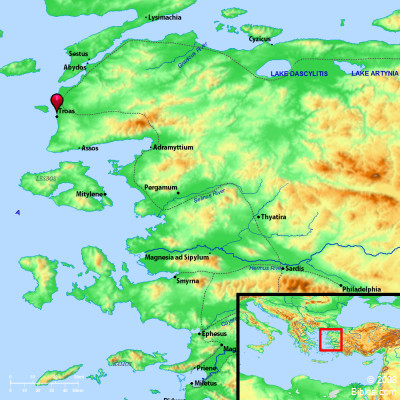Atlas  Troas and surrounding region Maps Created using Biblemapper 3.0 Additional data from OpenBible.info You are free to use up to 50 Biblos coprighted maps (small or large) for your website or presentation. Please credit Biblos.com. Occurrences Acts 16:8 Passing by Mysia, they came down to Troas.Acts 16:11 Setting sail therefore from Troas, we made a straight course to Samothrace, and the day following to Neapolis; Acts 20:5 But these had gone ahead, and were waiting for us at Troas. Acts 20:6 We sailed away from Philippi after the days of Unleavened Bread, and came to them at Troas in five days, where we stayed seven days. 2 Corinthians 2:12 Now when I came to Troas for the Good News of Christ, and when a door was opened to me in the Lord, 2 Timothy 4:13 Bring the cloak that I left at Troas with Carpus when you come, and the books, especially the parchments. Encyclopedia TROAStro'-as (Troas): The chief city in the Northwest of Asia Minor, on the coast of Mysia in the Roman province of Asia. From here, according to Acts 16:8, Paul sailed. Here, also, according to Acts 20:5-12, Paul raised Eutychus from the dead. The name Troas was not confined to the town itself, but it was also applied to the surrounding district, or to that part of the coast which is now generally known as the Troad. In its early history it bore the name of Antigona Troas, which was given it by its founder Antigonus, but after 300 B.C. it was generally known to the classical writers as Alexander Troas, a name given to it by Lysimachus. For a time the Seleucid kings made their homes at Troas. Later, when the city became free, it struck its own coins, of which vast numbers are found; a common type is one upon which is stamped a grazing horse. In 133 B.C. Troas came into the possession of the Romans, and later, during the reign of Augustus, it was made a Roman colonia, independent of the Roman governor of the province of Asia. Its citizens were then exempt from poll and land tax. During Byzantine times Troas was the seat of a bishopric. TRO'AS, a city of Mysia, on the n.w. coast of Asia Minor, 6 ms. s. of the entrance to the Hellespont; it is an utter ruin, now called Eski Stamboul, or old Constantinople. Strong's Greek G5174: TrasTroas, a city near the Hellespont (i.e. Dardanelles) |



